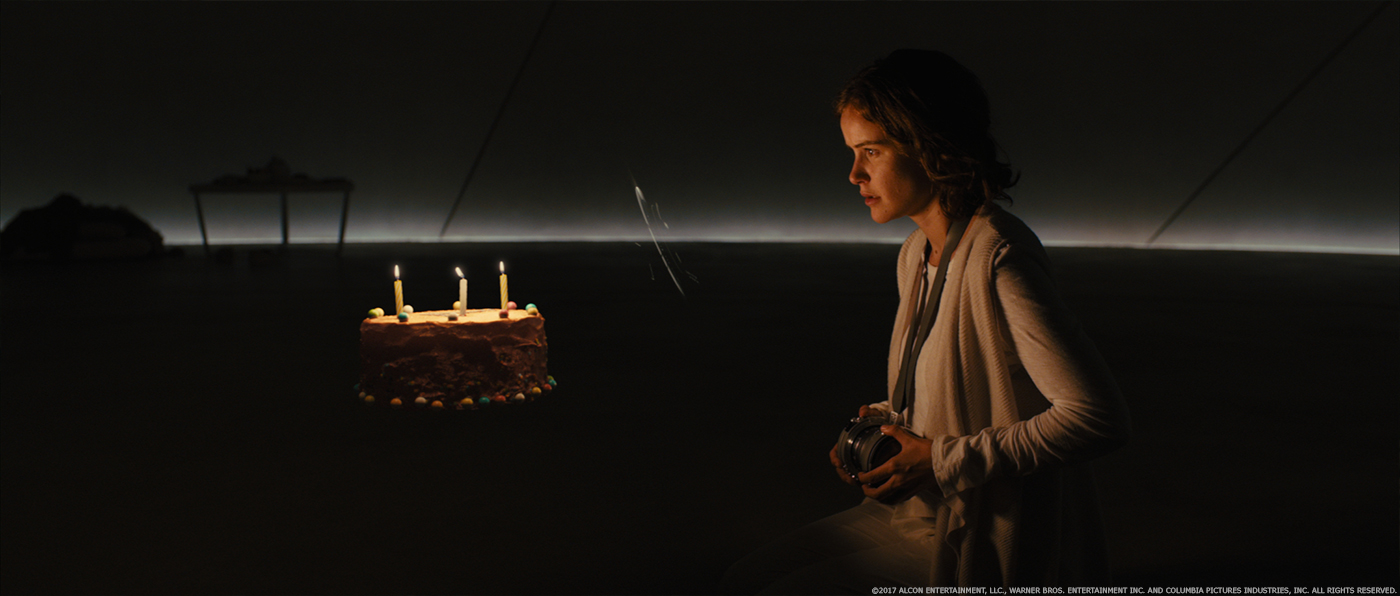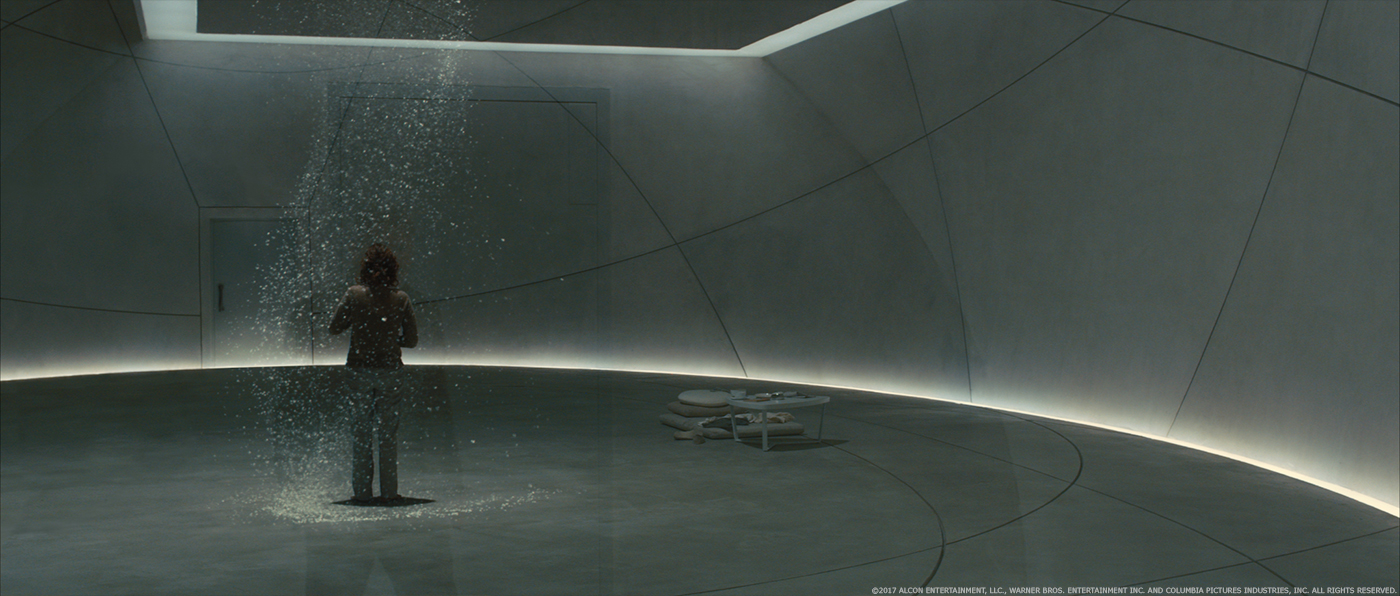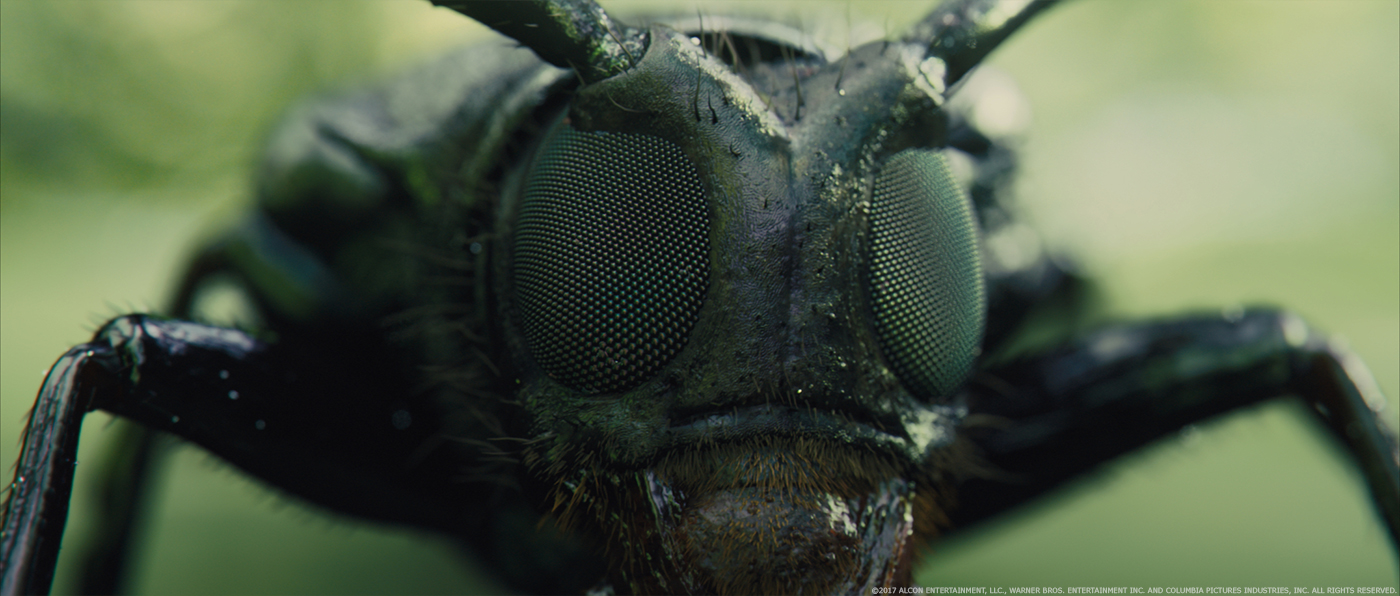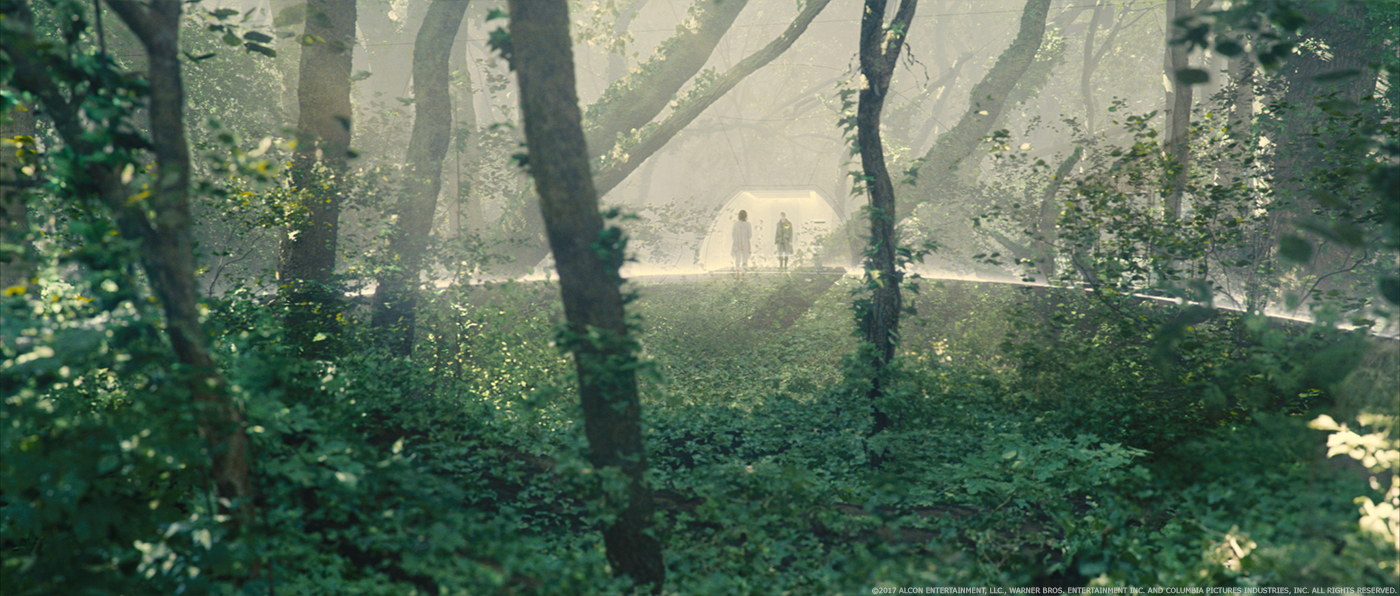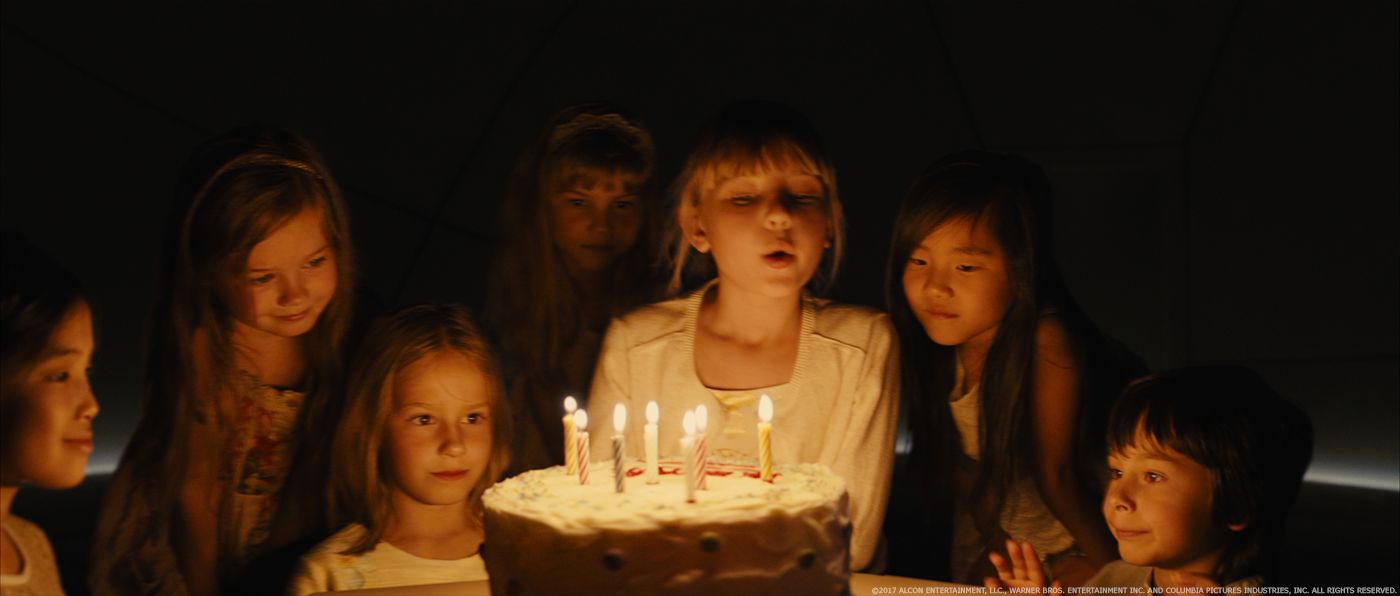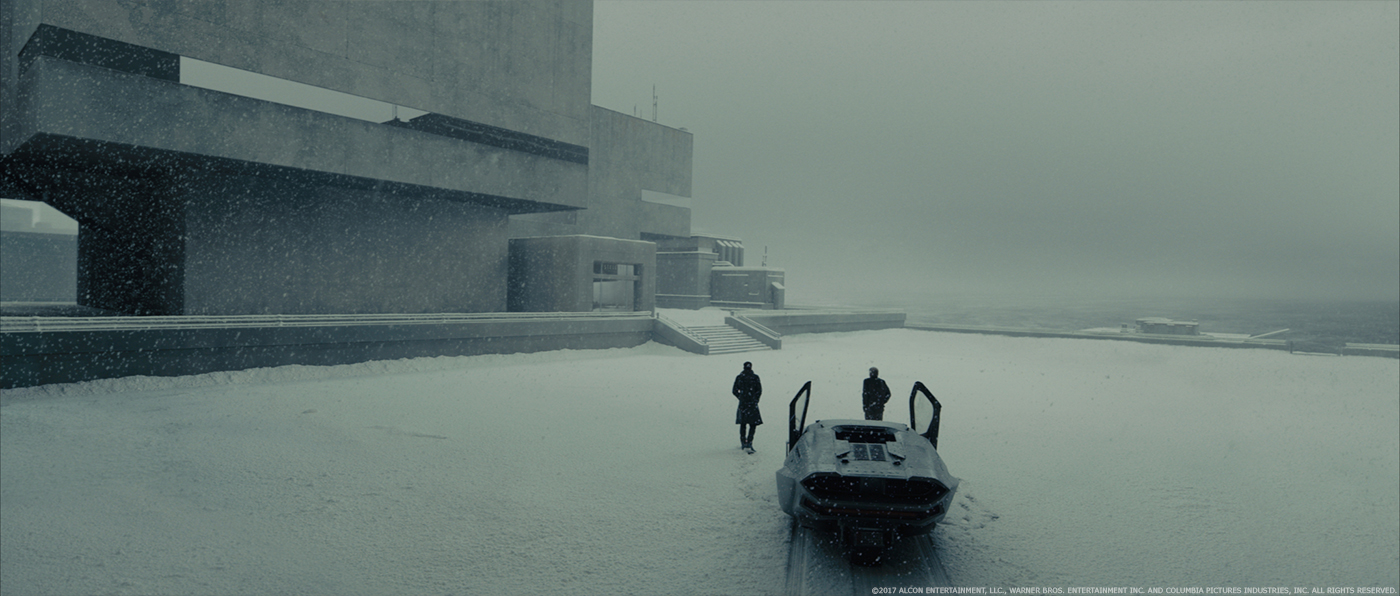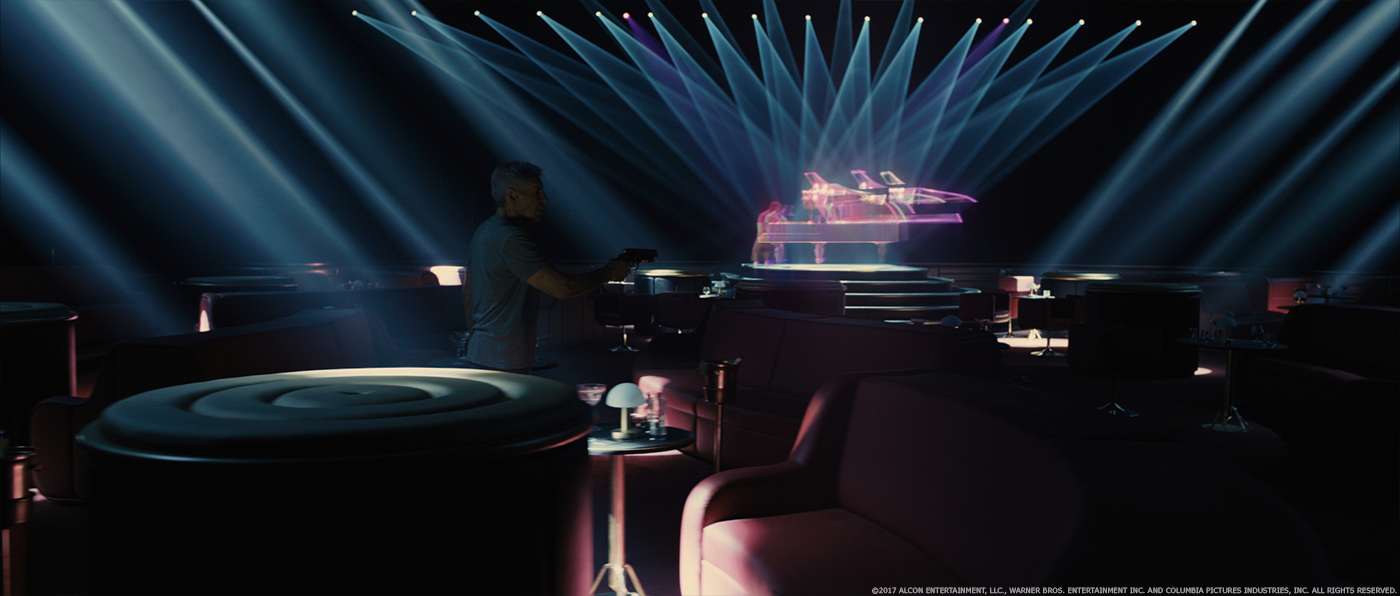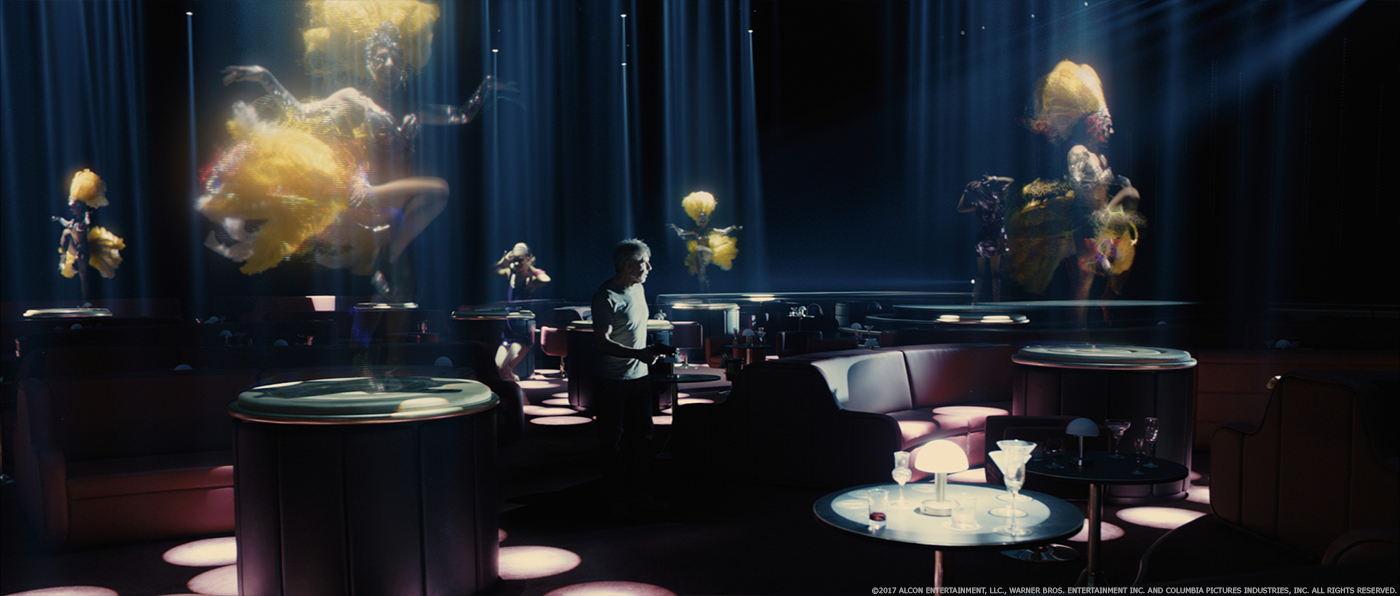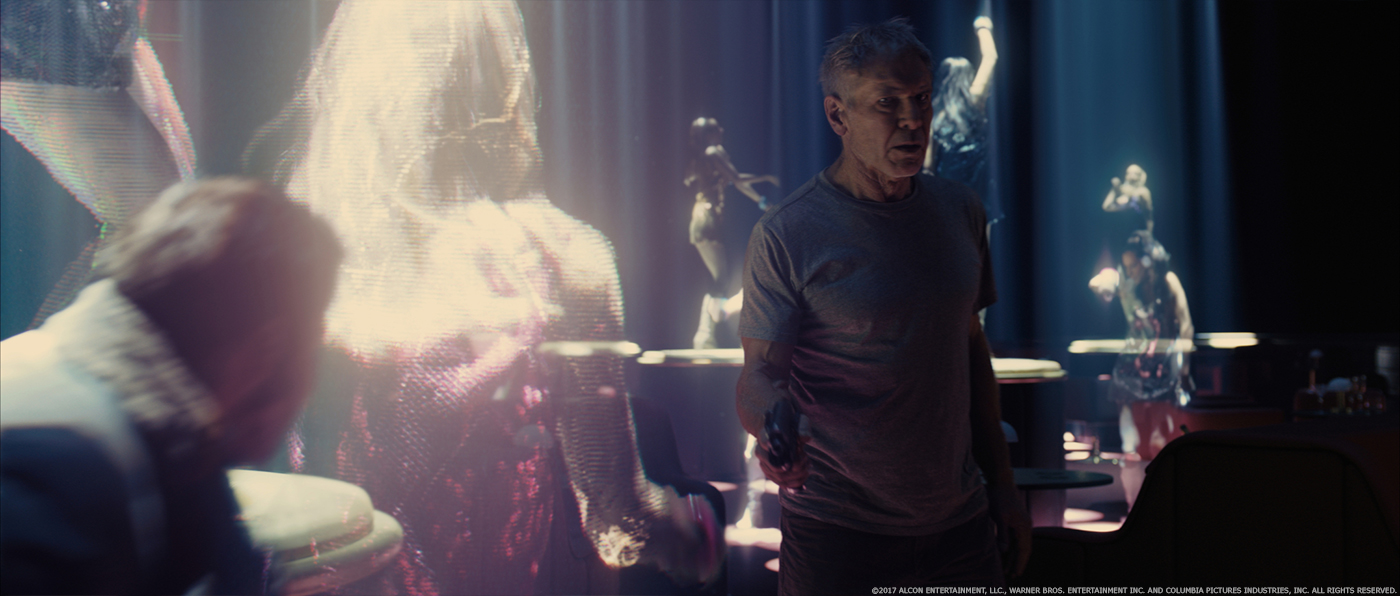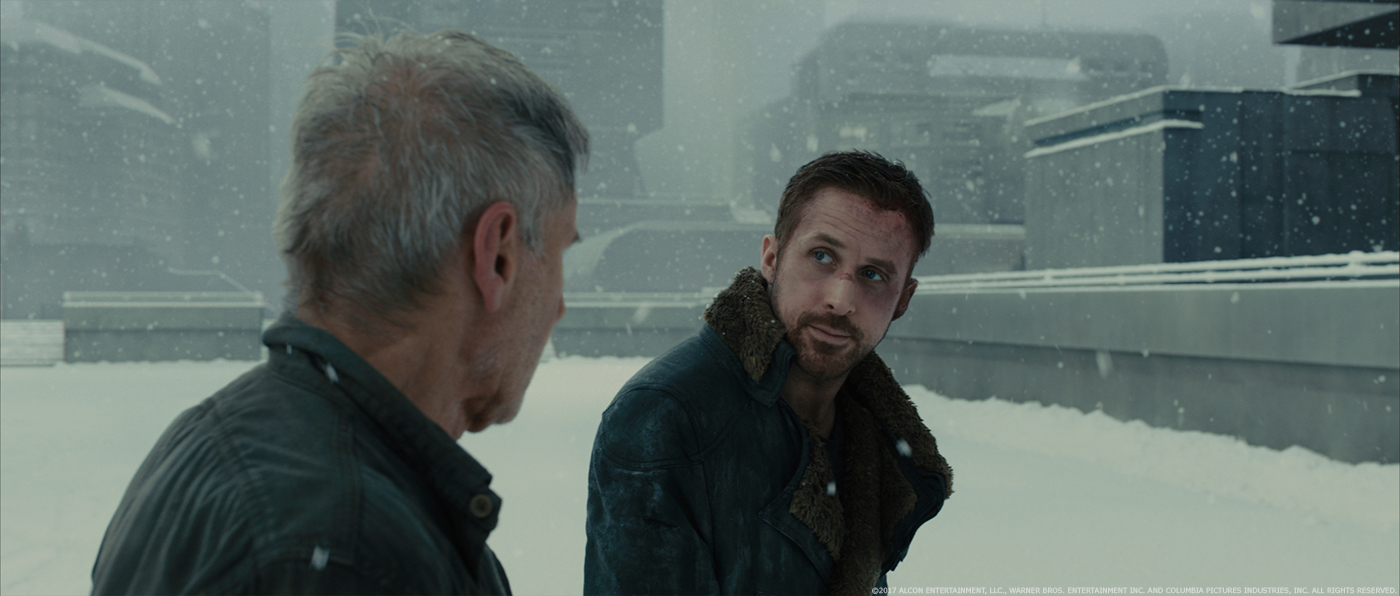In 2012, Olivier Cauwet explained the work of BUF on TOTAL RECALL. He then took care of many projects such as COSMOS: A SPACETIME ODYSSEY, INDEPENDENCE DAY: RESURGENCE, AMERICAN GODS or TWIN PEAKS.
Jeremy Robert began his VFX career at BUF in 2007. As a VFX supervisor, he was responsible for the visual effects of films such as POLTERGEIST, RACE, X-MEN: APOCALYPSE or AMERICAN GODS.
How did you and BUF get involved on this show?
In 2016, VFX supervisor John Nelson offered BUF the chance to be involved on a few sequences of BLADE RUNNER 2049. Pierre Buffin then asked me to accompany him on set, to oversee the shooting of the shots awarded to BUF Paris.
En 2016, BUF a été contacté par le superviseur VFX, John Nelson, pour travailler sur plusieurs séquences de BLADE RUNNER 2049. Pierre Buffin m´a demandé de superviser avec lui le tournage et les effets des plans attribués à BUF Paris.
How was the collaboration with director Denis Villeneuve and Director of Photography Roger Deakins?
We were in touch with Denis Villeneuve during the whole preparation stage: through John Nelson, we shared some graphic proposals for the holograms displaying various looks, glows, transparencies and deformations. Those designs enabled us to further discuss the visual appearance Denis expected for Elvis, Marilyn and all the dancers. Throughout shooting, Denis was paying attention to any and every little detail, all while constantly making sure we had everything we needed to work. You could see how truly humble and attentive he can be when it comes to his movie. We interacted with Denis again at the end of post-production, during our weekly reviews with John, to present him with the latest iterations of our work.
Things were different with Roger Deakins, seeing as most choices had been made ahead of time with John Nelson. Still, we were lucky enough to see him working on the lighting -the one he created for HoloFunHouse is simply unbelievable, and we got to discuss the visual atmosphere for Ana’s lab with him. Believe me when I say that you can’t forget reviewing your work with Denis, Roger or John: their input is always constructive, and aims to make you improve yourself.
Avec Denis Villeneuve, nous avons surtout échangé durant la préparation. Par l´intermédiaire de John Nelson, nous lui avons proposé des recherches graphiques sur les hologrammes. Leurs looks, leurs brillances, leurs transparences, leurs déformations. Sur la base de ces designs nous avons discuté avec Denis du visuel qu´il voulait pour Elvis, pour Marilyn et toutes les danseuses. Lors du tournage, Denis, très attentif à tout, venait nous demander, de temps en temps, si nous avions tous les éléments nécessaires et si tout était bon pour nous. On ressent beaucoup d´humilité de sa part et une grande attention portée à tout ce qui touche au film. Nous retrouverons Denis en fin de postproduction lors de nos reviews hebdomadaires avec John pour présenter notre travail en phase de finalisation.
Avec Roger Deakins, les discussions et les choix de tournage étaient établis en amont avec John. Au delà d´avoir eu la chance de voir Roger D travailler la lumière, celle du holofunhouse est juste incroyable, nous avons surtout échangé lors de nos reviews sur les ambiances extérieures du Laboratoire d´Ana. Quand vous présentez et discutez du travail de votre équipe avec Denis, Roger et John, croyez moi ce sont des moments qui ne s’oublient pas. Leurs retours sont toujours constructifs et justes. Ils vous font progresser.
What was their approaches and expectations about the visual effects?
When you see how qualitative and visually rich the film is, you understand that the effects had to be both realistic and significant story-wise. Whether they’re very present or anecdotal, they have all been analyzed in the light of dramatic stakes: everything you see has thus been fully thought through.
Quand on voit la qualité et la richesse visuelle du film, les effets doivent être réalistes et apporter à l’univers. Qu’ils soient importants ou un simple détail dans la séquence, les effets sont toujours pensés, analysés du point de vue de l’histoire, de l’action et du ressenti. Tout est maitrisé.
Can you tell us more about your work with VFX Supervisor John Nelson and VFX Producer Karen Murphy?
Working with John Nelson was an amazing experience. He’s a very hard-working person, always searching for a new idea, for the one detail that will change everything -for the better. Effects can never be trivial with him. When he explains an effect, he takes the time to walk you though its context, its meaning, but also what it must add to the sequence and eventually to the movie. You can feel how he doesn’t let images limit his reflexion, because in the end his priority is that everything makes sense. When you discuss a shot with him, you can see that he leaves nothing to chance. His feedback is both relevant and explanatory, thus proving how sharp his insight really is.
Since we were working on a very graphic sequence for the HoloFunHouse, John was completely open to ideas, designs and any other visual proposals for the holograms. We provided him with extensive research material, which he narrowed down to a few options before presenting Denis with them. Pierre and myself were both asked to specifically prepare and oversee filming for this sequence, which was technically and logistically complex. At first, we followed the main team for a three days shooting with Harrison Ford and Ryan Gosling . John then let us handle the second shooting session, with all the dancers and the doubles (for Elvis, Marilyn and Sinatra).
Once we were back in Paris for post-production, both Paris and Montreal maintained weekly contact with him: we had shared cineSyncs that started at 11am LA / 4pm MTL / 9pm Paris, and could last for more than two hours.
Ce fut une expérience incroyable de travailler avec John Nelson. John est un travailleur acharné, toujours à la recherche d’une idée, du détail qui fera la différence. Celui qui fera qu’un plan est toujours mieux. Il n’y a jamais de petits effets avec lui. Quand il explique un effet, il parle de son contexte, de son sens, de ce qu’il va apporter à la séquence, au film. On sent une véritable réflection de sa part qui ne s’arrête pas uniquement à l’image, il y a un sens à tout. Quand on discute avec John d’un plan, il a le regard aiguisé, rien ne lui échappe. Ses retours sont pertinents et accompagnés d’explications.
Comme nous avons travaillé sur une séquence très graphique, le Holofunhouse, John était très demandeur d’idées, de designs de propositions visuelles pour les hologrammes. Nous lui avons transmis toutes nos recherches, parmi lesquelles il faisait une sélection pour les présenter à Denis. John nous a demandé, à Pierre et moi, de préparer et superviser cette séquence. Une séquence compliquée d’un point de vue technique et logistique. Nous avons accompagné en présence de John la première équipe qui tournait uniquement avec Harrison Ford et Ryan Gosling, pendant 3 jours. Puis John, qui est essentiellement en première équipe nous a laissé gérer le tournage de la seconde équipe pour filmer les danseuses et les doublures d’Elvis, Marilyn, Sinatra dans le décor.
Une fois de retour à Paris pour la postproduction, nous étions BUF Paris, BUF Montréal et John Nelson en contact hebdomadaire. Nous organisions des cineSync communes, 11am pour LA, 4pm pour Montréal et 9pm pour Paris. Cela pouvait durer plus de 2h.
What was your feeling to work on the sequel of this cult movie?
Pride, which is a feeling shared by the whole team at BUF. The pressure was of course always there, seeing as BLADE RUNNER has forever branded science-fiction, but it actually prompted us to do our very best. I already loved Denis’ previous films, and I had heard that he was involved on this sequel, but I never would have dreamed of working on it. Being a part of this adventure meant getting a chance to imprint a small part of ourselves on the movie, which left a very strong impression on all of us.
De la fierté, et c’est un sentiment partagé par toute l’équipe de BUF. Il y a toujours de la pression, BLADE RUNNER a tellement marqué le cinéma de science fiction, mais elle vous fait vous surpasser. J’aime beaucoup ses précédents films et je savais que Denis Villeneuve planchait sur la suite, mais de là à s’imaginer travailler dessus. On y a participé, donc apporté un peu de nous. C’est un sentiment très fort pour tout le monde.
What are the sequences made at BUF and how did you organize the work at BUF?
BUF worked on 5 sequences shared between our facilities in Paris and Montreal.
Jeremy Robert was in charge of the sequences in Montreal.
In Paris, we were involved on 3 sequences:
HoloFunHouse: we re-created the holograms of various well-known shows. They all start to get mixed up while Deckard and K. fight, and you can see the holograms of 80 dancers (with Folies Bergeres, gogo dancers or even cow girls), but also Elvis Presley and Marilyn Monroe.
Drink with Frank: we created Frank Sinatra’s hologram, which appears in the jukebox singing “One for my Baby”.
Last Stand Off: this is the ending sequence. We crafted the whole snowy environment that surrounds Deckard and K. You can see Los Angeles, Ana’s lab and the horizon of a frozen ocean.
In Montreal, we worked on two sequences:
Ana’s memories lab: we created the shape-shifting insect, the forest hologram and the birthday memories. We were also asked to tweak the set, the lab’s scanner and the snow’s hologram around Ana.
Last Stand Off: we produced the lab extension and the police spinner.
BUF a travaillé sur 5 séquences que nous avons distribué entre BUF Paris et BUF Montréal.
Jeremy Robert était en charge de la supervision des plans à Montréal.
A Paris nous avons réalisé 3 séquences :
Holofunhouse : Nous avons recréé les spectacles d’hologrammes qui se mélangent et entourent la lutte entre Deckard et K. On peut y voir les hologrammes de 80 danseuses, Folies Bergères, gogo danseuses, cow girls, mais aussi d’Elvis et de Marilyn.
Drink with Frank : Nous avons créé l’hologramme de Frank Sinatra qui apparaît dans le jukebox. Il chante « One for my baby ».
Last Stand Off : C’est la séquence de fin, Nous avons réalisé tous l’extérieur qui entoure Deckard et K, sous la neige. On y voit Los Angeles, le laboratoire d’Ana, et l’horizon d’un océan glacé.
A Montréal nous avons réalisé 2 séquences :
Ana’s Memories Lab : Nous avons créé l´insecte qui change de forme. L´hologramme de la forêt. La création des souvenirs de l´anniversaire. Divers retouches sur le décor intérieur et le scanner du laboratoire et l´hologramme de la neige autour d´Ana.
Last Stand Off : Nous avons réalisé les extensions du laboratoire et les plans du spinner de la police.
How did you approach the Ana’s memory lab sequence?
// Jeremy Robert: “Ana’s work is closer to an art than a technology. After John Nelson’s coming in our Montreal facility, we had a research angle. The videoclip of ” Like a Rolling Stone “, made by BUF in 1995, had draw his attention. The idea of light projection was also part of his approach for the holographic representation. Afterward, the storyboard gave us more indications onto what we would have to represent. Ana recreates, invents, for most of them, the images implanted in the artificial memory of the replicants. She gives them an identity background. In this sequence, our work was rather based on the “creation”, the “representation” of these memorial images… The field of the possibilities was extremely opened.”
Can you explain in details about the design and creation of the memories?
// Jeremy Robert: “Denis Villeneuve wanted an effect strongly visual that was both poetic and subtle. This sequence is composed of three distinct stages. The work on insects, the dissipation of the forest and the creation of the birthday. Light was the guiding thread for the materialization and modification of the holograms. We therefore launched a long phase of visual researches around this concept. We had to recreate several insects in 3D, directly taken from Pierre Buffin’s personal collection. I decided to approach the modeling of these in a less conventional way after seeing the work of a Spanish academic based in Granada. He does research on the anatomy of insects, by scanning objects, making a maximum of 2.5 cm with an impressive precision, the microscopic hairs being also captured. The definition obtained is at the micrometer level. Close to ultrasound imaging, the image sequences obtained with this scanner have allowed us to recreate an extremely accurate and anatomically detailed model for our insects. Some details, such as hairs, mandibles and eye patterns, required more specific work.
The forest where Ana stands is dissipated to leave room for her laboratory. Two shots that required the reconstruction of a vast forest. Based on a 3D scan of the filming location, the scanned portion was too short to cover the wide view of the shot that closes the disappearance. Many 3D elements have been created to give life to this forest. Like the neon lights of a corridor, parts of the forest disappear to leave room for a few trees and then the laboratory.
Then she makes the cake of a birthday party… Children around a table ready to blow the candles. Several cakes were filmed and then scanned in 3D, which gave us all the latitude to play with the shapes, the colors and the details. Regarding the children, in addition to the camera dedicated to the framing of the shot, we added 2 to 4 additional cameras focused on the party. The number of cameras allowed us to recreate a certain rotation by morphing all camera angle together. Each shot was timed accurately. At first with simplistic composites based on blend and retime of the different plates. This technique allows to preserve the “photographic/analogical” feeling of the shot by avoiding to bring back a digital side to the effect. Many parts of the children appeared missing to make the applied rotation as elegant as possible. To finalize these shots, a big reconstruction work on the children had to be done. These technical considerations settled, we only had to integrate the birthday party alongside Ana, in her laboratory.”
// Jeremy Robert: « Denis Villeneuve voulait un effet visuellement fort a la fois poétique et subtile. Cette séquence est composée de trois étapes distinctes. Le travail sur les insectes, la dissipation de la foret et la création de l’anniversaire. La lumière étant le fil conducteur pour la matérialisation et la modification des hologrammes, nous avons donc lancé une longue phase de recherche visuelle et de tests autour de ce concept. Nous avons dû recréer plusieurs insectes en 3D, directement tirés de la collection personnel de Pierre Buffin. J’ai décidé d’aborder la modélisation de ceux-ci d’une manière moins conventionnelle après avoir vu le travail d’un universitaire espagnol basé à Grenade. Prof Javier Alba-Tercedor fait des recherches sur l’anatomie des insectes, en scannant des objets faisant un maximum de 2.5 cm avec une précision impressionnante. Les poils microscopiques sont eux aussi captés. La définition obtenue est au niveau du micromètre. Proche de l’imagerie échographique, les séquences d’images obtenues avec ce scanner nous ont permis de recréer un modele extrêmement juste et détaillé anatomiquement pour nos insectes. Certains détails, comme les poils, les mandibules et le motif des yeux ont demandé un travail plus particulier.
La forêt dans laquelle se trouve Ana se dissipe pour laisser place à son laboratoire. Deux plans qui ont nécessité la reconstruction d’une vaste forêt. Base sur un scan 3D des lieux du tournage, la portion scannée était trop succincte pour couvrir le large point de vue du plan qui clôture la disparition. Beaucoup d’éléments 3D ont été crées pour donner vie a cette forêt. A l’image des néons d’un couloir, des pièces de la forêt disparaissent pour laisser place à quelques arbres puis au laboratoire.
Ensuite, elle confectionne le gâteau d’une fête d’anniversaire… Des enfants autours d’une table prêts a souffler les bougies. Plusieurs gâteaux ont été shootés puis scannés en 3D, ce qui nous a donné toute la latitude pour jouer avec les formes, les couleurs et les détails de ceux-ci. Pour les enfants, en plus de la camera dédiée au point de vue du plan, nous avons ajouté 2 à 4 cameras supplémentaires orientées sur la fête. Le nombre de camera nous permet de recréer une certaine rotation en morphant les prises de vue ensembles. Chaque plan à été timé avec précision. Dans un premier temps avec des composites simplistes basée sur le blend et le retime des différentes plates. Cette technique permet de conserver le feeling “photographique/analogique” de la prise de vue en évitant de ramener un cote “numérique/digital” a l’effet. Beaucoup de parties des enfants sont apparues manquantes pour que la rotation appliquées soit la plus élégante possible. Pour finaliser ces plans, un gros travail de reconstruction à dû être fait. Ces considérations techniques réglées, nous avions plus qu’a intégré les enfants au cote d’Ana dans son laboratoire.»
How did you handle the difference of space and time of the memories?
// Jeremy Robert: “The methodology set up for children’s shots, called “ARRAY SHOT” for the occasion, allowed us to have a certain latitude on the time without impacting the movement. Working with perfectly synchronized fixed camera angle allowed us to sequence the work. The first stage deals with the time, the back and forth in the children’s acting, and then the second one with the rotation brought by the morphing. Once these technically set up, we could play with the rotation without having any influence on the proper time of the action.”
// Jeremy Robert: « La méthodologie mis en place pour les plans d’enfants, que l’on a baptise “ARRAY SHOT” pour l’occasion, nous permettait justement d’avoir une latitude sur le temps sans impacter le mouvement. Le fait de travailler des prises de vue fixes parfaitement synchrones nous a permis de séquencer le travail. La première étape traitant le temps, le jeux de va et viens dans l’action des enfants, puis la seconde, celle de la rotation apportée par le morphing. Une fois ceux-ci techniquement mis en place, il nous était possible de jouer avec la rotation sans avoir d’influence sur le temps propre de l’action. »
Can you tell us more about this shooting?
// Jeremy Robert: “This took place in Budapest, Hungary. The first week of shooting in July 2016. Teams had to get acquainted and all the actors of such an undertaking needed time to settle and work together. Then we went to the studio to shoot the elements for the birthday party. The deadlines were quite tight, so we needed a lot of energy and concentration to guide the team in the placement and setup of cameras. An essential step for the success of the children’s shots.”
// Jeremy Robert: « En Hongrie, à Budapest. La première semaine de tournage en juillet 2016. Les équipes devaient faire connaissances et tous les acteurs d’une telle entreprise ont besoin de temps pour se régler et travailler ensembles. Nous avons commencé par le plan qui se passent en forêt, puis nous sommes passé en studio pour shooter les éléments pour le birthday party. Les délais étaient assez serrés, donc beaucoup d’énergie et de concentration pour guider l’équipe dans le placement et le setup des cameras. Etape primordial pour la réussite des plans d’enfants. »
How did you extend the set?
// Jeremy Robert: “Denis Villeneuve had a very clear vision of what had to be the place on which is located Ana’s laboratory, the surrounding city and the icy horizon. The Montreal team was in charge of the building of the asset used to extend the laboratory’s exterior shots. We modeled and textured the buildings with a frank direction, the brutalism. Several architectural proposals for this environment were brought, especially for the laboratory. But Denis Villeneuve knew what that place had to look like. John Nelson and the designs allowed us to settle this cold and austere digital set. Then BUF Paris team took over, under the supervision of Olivier Cauwet to bring back the snowy atmosphere of the end of the movie.”
// Jeremy Robert: « Denis Villeneuve avait une vision très claire de ce que devait être la place sur laquelle siégeait le laboratoire d’Ana, la ville environnante et l’horizon glacial. L’équipe de Montréal était en charge de la construction de l’asset utilise pour étendre les plans extérieurs du laboratoire. Nous avons modélisé et texture les bâtiments avec une direction franche, le brutalisme. Plusieurs propositions architecturale pour cet environnement ont été amenées, surtout pour le lab. Mais Denis savait à quoi devait ressembler cet endroit. John et les designs nous ont permis de poser ce décor froid et austère. Nous avons finalisé quelques extensions de décor, lors que K quitte le laboratoire d’Ana. Puis l’équipe de BUF Paris à prit le relais, sous la supervision d’Olivier Cauwet pour ramener l’ambiance enneigée de la fin du film. »
We discover holograms of Sinatra, and later Elvis, Marilyn and Liberace. Can you explain in detail about their design and creation?
To create Elvis’ hologram, we first shot the choreography executed by a stand-in using multiple cameras, lit in the exact same way as the set. Since the double was shorter than the singer, we had to carefully rotoscope him in 3D and re-adjust his mensurations to fit Elvis’. That in itself already implied the creation of two separate 3D setups: one for the double, and one for the King. Once the first had been rotoscoped, we were able to project his costume on each image and then report that on the Elvis asset, along with his animation. As proportions were different though, we had to erase his microphone and revise the animation in 3D. For his face, we reviewed hundreds of photos circa 1970 -and sometimes beyond that era. Pictures from his youth for example were very precious references to shape his face in the way that made it so specific, but also his ears and hairline. At that time, his shorter haircut made it indeed easier to assess those details. To model his face, we selected and rotoscoped dozens of pictures seen from different angles, with the most neutral countenance possible. As for his expressions, we tried to get as close as possible to his actual demeanor during live shows. To that end, we 3D rotoscoped concert videos, such as « Suspicious Minds, Elvis that´s the way it is, in 1970 ».
Just like we did for the dancers, we then converted him into particles to generate the hologram effect, but also the glitches that hinder his performance in the movie.
For Frank Sinatra, the choreography was also shot on green screen with a look-alike. We knew that the hologram would have to stand on top of the jukebox, and be 5 times smaller than his real-life alter-ego. To fit those size/position requirements, we therefore had to find the perfect camera angle that would allow us to film the actor In the right perspective for each shot. The double was quite broader than the actual Frank, which called for some morphing in order to make him both shorter and thinner. We also tweaked his acting (when he moves his arm) to fit more elegantly in the edit. To model his face, we selected and rotoscoped dozens of pictures as well, seen from various angles. To get his expressions right, we then 3D rotoscoped the concert « Frank Sinatra – One For My Baby in 1962 ».
Regarding Marilyn, we knew that she would only appear in a locked-off shot, and stay practically still. As a result, our approach was quite different. We shot a Marilyn look-alike on green screen, then rotoscoped and adjusted her body proportions through a 2D warp. For her face, we 3D rotoscoped the double and mixed her skin/facial expressions with some of the icon’s very recognizable traits.
Pour la création de l´hologramme d´Elvis, nous avons tourné la chorégraphie de la doublure à plusieurs caméras, dans la même lumière que les plans. La doublure est plus petite qu´Elvis, nous l´avons donc rotoscopée méticuleusement en 3D pour réajuster l´acteur aux proportions du chanteur qui est bien plus élancé. Cela implique la création de deux setups 3D complets. Un premier pour la doublure et un second pour Elvis. Une fois le premier rotoscopé, son costume est projeté à chaque image puis reporté sur le setup d´Elvis ainsi que son animation. Les proportions changent, il faut donc effacer le micro et le réanimer en 3D. Pour le visage nous avons visualisé des centaines de documents photos et videos autour de la période 1970. Nous ne nous sommes pas uniquement limités à cette période. Les photos de sa jeunesse nous ont bien orientés sur les volumes de son visage, si spécifiques, la forme de ses oreilles et l´implantation de ses cheveux. A cette époque sa coiffure était bien plus courte et ne cachait pas tous ces détails. Nous avons sélectionné et rotoscopé des dizaines de photos, dans différents angles, du visage d´Elvis le plus neutre possible. C´est sur cette base que nous avons modélisé son visage. Pour les expressions nous avons rotoscopé en animation 3D des vidéos de concerts comme celui de « Suspicious Minds, Elvis that´s the way it is, en 1970 » pour être plus proche du jeu d´Elvis en concert. Comme pour les danseuses, il est ensuite converti en particules pour générer l´effet d’hologramme et les glitches qui perturbent son show.
Pour Frank Sinatra, la chorégraphie est tournée avec une doublure sur fond vert. L’hologramme de Frank Sinatra est 5 x plus petit que sa taille réelle et se positionne sur le haut du jukebox. Il faut donc pour chaque plan calculer la position de caméra qui permettra de filmer l’acteur dans la bonne perspective une fois l´hologramme réduit et replacé à hauteur du jukebox. La doublure était bien plus massive que Frank. Il a fallu ajuster en morphing sa corpulence à la morphologie de Frank, bien plus petit et sec. Nous avons aussi modifié son jeu ( mouvement du bras ) pour améliorer le raccord au montage. Pour le visage, nous avons sélectionné et rotoscopé des dizaines de photos, dans différents angles, du visage de Frank. C´est sur cette base que nous avons modélisé son visage. Pour les expressions nous avons rotoscopé en animation 3D le concert « Frank Sinatra – One For My Baby en 1962 ».
Marilyn apparait uniquement dans un plan fixe. Elle est quasiment statique. Notre approche a donc été différente. Nous avons tourné une doublure de Marilyn Monroe sur fond vert. Puis nous avons rotoscopé et ajusté son corps aux proportions de Marilyn avec un warp 2D. Pour son visage, nous avons rostoscopé en 3D le visage de la doublure et mixé les traits caractéristiques de Marilyn avec la couleur de peau et les expressions de la doublure.
How did you handle the lighting challenges?
The HoloFunHouse was first shot with only Harrison Ford and Ryan Gosling, and its very strong light variations prompted us to use led trackers. Each camera position was marked on the ground, so that we could get them right when filming with the second team 3 days later.
Using the first edit as reference, we went back on the same set to shoot the dancers (Folies Bergères, gogo dancers, cow-girls) and Elvis’ double. The camera placements were the same, though the material we had sometimes wasn’t the one used by the main team. That meant we had to compensate the super Technocrane large movements, using three locked off cameras placed on its original trajectory -the 3 views being put together afterwards through a morph to mimic the traveling. As the holograms were to be transparent, we had to shoot each layer of dancers separately to avoid any juxtaposition. The light for each show had been previously recorded on a console by the main team, so that it could be played at will with the dancers (to ensure smooth integration, it was necessary to have the exact same lighting). We also synchronized the witness cameras that recorded the lights on the ceiling, so we could accurately reproduce them in 3D.
Le holofunhouse a été uniquement tournée avec Harrison Ford et Ryan Gosling. En raison des fortes variations de lumières, nous avons utilisé des trackers led. Toutes les positions de caméra ont été marquées au sol, afin de les repositionner correctement en seconde équipe.
3 jours plus tard, avec un premier montage comme référence, nous sommes retourné dans le décor pour tourner les danseuses ( Folies Bergères, Gogo danseuses, Cowgirls ) et la doublure d´Elvis. La caméra est repositionnée à l’identique pour chaque plan. Dans certains cas, n’ayant pas le même équipement qu’en première équipe, nous avons compensé les grands mouvements avec la super Technocrane par 3 caméras fixes placées le long de sa trajectoire. Les 3 vues seront raccordées en morphing pour redonner l’illusion du travelling. Les hologrammes étant transparents, toutes les couches de danseuses ont été tournées séparément afin d’éviter les recouvrements. Le lightshow dédié à chaque spectacle était enregistré en première équipe sur console, pour être rejoué avec les danseuses. Il était crucial que le jeu de lumières soit identique aux deux tournages pour que l´intégration fonctionne. Nous avions aussi synchroniser des caméras témoins qui enregistraient le plafond de lumières, pour pouvoir ensuite les reproduire précisément en 3D.
Did you received specific indications and references for the holograms?
To define the hologram’s look, we produced a significant amount of 2D graphic research, as well as dozens of 3D tests to present John and Denis with. Since the HoloFunHouse holograms are supposed to be obsolete in the film, their quality was therefore voluntarily altered. Compared to those from 2049, they had to embody what VHS tapes would be compared to blue-rays nowadays. For each shot, we 3D rotoscoped the dancers in order to convert them into particles -which enabled us to experiment with the idea of pixels in space. Particles also gave us more breathing room to create the hologram effect and the glitches that come with it, whereas lines would have matched the dancers’ shapes and revealed some hidden transparencies in the process. The perturbations are in fact “temporal glitches”, that is to say a mix of different positions all combined into one image. We also added glitches obtained from spatially distorting the holograms and the dancers’ figures. Even the chromatic aberrations were generated through particles: there was almost no 2D involved. We extensively used our “Neuro” system and our script language (“Blast”) to easily monitor and visualize all the above-mentioned particles effects.
Pour définir le look et les perturbations des hologrammes, nous avons réalisé beaucoup de recherches graphiques 2D ainsi que des dizaines de tests 3D. Nous les avons présenté à John et Denis pour définir le style voulu. Les hologrammes du « holofunhouse » sont d´une vieille génération, leurs qualité est altérée. Comparés aux hologrammes de 2049, ils sont ce que la VHS est au Blu-ray aujourd’hui. Pour chaque plan, nous avons rotoscopé en 3D les danseuses, afin de les convertir en particules 3D. Cela nous a permis de jouer avec la notion de pixel dans l´espace. Les particules nous offrent plus de latitude pour créer l´effet hologramme et ses perturbations. Les lignes peuvent suivre les formes de la danseuse, et révéler les faces cachées en transparence. Les perturbations, sont des glitches temporels, c´est a dire un mélange de différentes positions de la danseuse en une image. D´autres glitches sont des déformations spatiales de l´hologramme, des distorsions de la silhouette des danseuses. Même les effets de décalage chromatique sont générés en particules, il n´y a quasiment pas d´effets 2D. L´utilisation de notre système « Neuro » et de notre langage script « Blast » nous permettent de gérer et de visualiser rapidement les effets sur les particules.
Can you tell us more about the snow falling?
The edit revealed a continuity problem, seeing as the practical snow didn’t always have the same density throughout the sequence. We therefore had to erase the artificial flakes to replace them with 3D snow, which we then made slower and more aerial than they used to be. For continuity’s sake, we also modified the amount of snow on the characters’ clothes. We started with the end of the sequence and moved backwards shot by shot, to restore the excess of flakes on K and Deckard.
Le montage révèle un souci de continuité, la neige au tournage est plus ou moins dense suivant les plans. Nous l’avons donc effacée devant les acteurs et éléments de décor, pour la remplacer par de la neige 3D. Nous avons modifié son comportement pour la faire moins rapide et plus aérienne qu’elle ne l’était. Dans un soucis de continuité au montage, nous avons aussi géré la quantité de flocons sur les costumes. En partant du dernier plan de la séquence, nous sommes remonté plan par plan, effaçant les flocons en trop sur les cols, cheveux et épaules de K et Deckard.
Which sequence or shot was the most complicated to created and why?
Elvis and Frank, with no hesitation. We were tackling worldwide music icons, and even though I knew of Presley and Sinatra as much as the next person, I lacked the in-depth culture of their concerts.Elvis was a true showman, with very peculiar traits -truly a Greek profile. We had to collect tremendous amounts of pictures, videos, books and other documents to really enter the King’s world. As a matter of fact, John Nelson always advised us to do so, saying “you have to vibrate like Elvis. What does he think about when he’s singing?” Still, his expressions alter his face a lot, which is incredible but also very hard to recreate. In addition, you have to consider the fact that everyone has their own idea of what Elvis should look like, as well as the very intense physical changes he underwent depending on his age. We actually tried to put together a few live pictures of him, just for fun, and we noticed that he almost looks like a different person from one picture to the next! This kind of realization also revealed the complexity of our task: we began the project with those characters, and they accompanied us to the very end.
Clairement Elvis et Frank. Nous nous attaquions à des icônes américaines et mondiales de la musique. Je connaissais Elvis Presley et Frank Sinatra comme tout le monde, mais pas en détails, je n’avais pas cette culture d’Elvis, de ses spectacles. C’est un showman, avec des traits vraiment particuliers, un vrai profil grec. Nous avons observé énormément de documents vidéos, photos, livres pour s’en imprégner. John nous disait, « vous devez vibrer Elvis. Quand il chante à quoi pense t il ? ». Mais, son visage change du tout au tout selon ses expressions, c’est incroyable et très dur à recréer. Aussi, tout le monde se fait une interprétation personnelle d’Elvis. Physiquement, il change tellement selon son âge. On s’est amusé à disposer côte à côte des dizaines de photos d’Elvis en concert, on se disait, « mais ce n’est pas la même personne ! » Et là, la tâche qui nous incombe prend toute son ampleur. Nous avons commencé dès le début à travailler sur ces personnages, et nous avons fini avec eux.
What is your favorite shot or sequence?
I really like the HoloFunHouse and the Memories’s Lab sequence, because of their visual appearance and the complexity in the making they implied.
J’aime beaucoup celle du holofunhouse et du memories’ lab pour leurs visuels et toute la complexité de réalisation qu’elles impliquent.
What was the main challenge on this show and how did you achieve it?
The true challenge was the creation of Elvis and Frank’s holograms.
Le véritable challenge était de créer les hologrammes d’Elvis et Frank.
What is your best memory on this show?
That’s difficult to say, filming often determines the rest of a project’s atmosphere. In that case, it was a great show with very rich aesthetics -but also utterly demanding in terms of workload.
Difficile à dire, le tournage donne souvent le ton pour la suite. Ca a été un grand moment, riche et intense en travail.
How long have you worked on this show?
From preproduction to delivery, about a year.
De la pré-production, à la livraison des plans, environ 1 an.
What’s the VFX shots count?
106 shots.
106 plans.
What was the size of your team?
43 graphic artists were involved on the project.
Il y a eu 43 artistes qui sont intervenus au cours du projet.
What is your next project?
Nothing planned for now.
Rien de prévu pour le moment.
A big thanks for your time.
// WANT TO KNOW MORE?
BUF: Dedicated page about BLADE RUNNER 2049 on BUF website.
© Vincent Frei – The Art of VFX – 2017


